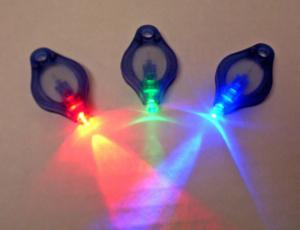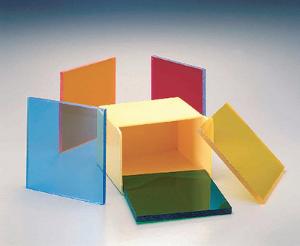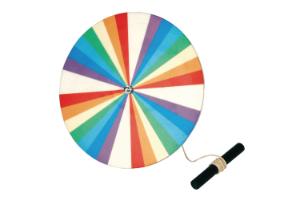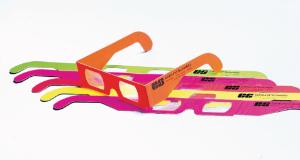Science of Color; Plus a free student handout from AccessScience
Access to this article is being offered to Ward's World readers for free from McGraw Hill's AccessScience. An award-winning gateway to scientific knowledge, AccessScience offers exclusive articles written by prominent scientists, links to primary research material, videos and animations, plus faculty-designed curriculum maps for teachers. To see more content like this, learn about subscription options, and request a free trial for your school, click here.
The team at Ward's World is excited to make available this powerful series of science articles from McGraw Hill’s AccessScience. This unique series fits our mission to find ways to bring you tips, ideas, and resources to help inspire students and guide discovery and learning. Look for a new McGraw Hill’s AccessScience article to be posted each month on Ward's World.
Ever since Newton first observed that a prism separates white light into the colors of the visible spectrum, scientists have made tremendous breakthroughs in optics, physics, chemistry, perception, and the study of color in nature.
There’s a broad spectrum of concepts your students can explore in color lessons. When viewed through the student’s prism, the science of color can shine a whole new light on the world around them. Eyes light up, and jaws drop when students learn color is not even a property of objects; it’s an interpretation of the mind based on invisible waves at different frequencies--cue eerie music here.
When you help illuminate how light is the missing link between objects and the colors we perceive, students will be fascinated but not surprised by facts like these:
- Most people think Polar bear fur is white. Polar bear fur is actually clear!
- There’s no pink (or magenta, to use its official name) in rainbows--except perhaps the beautiful rainbows drawn by kindergarteners.
- Vantablack is a material developed in the UK and is one of the darkest substances known, absorbing up to 99.965% of visible light. It can help improve how telescopes observe outer space.
- MIT engineers one-upped Vantablack by creating the blackest black coating from carbon nanotubes that are ten times darker than any material ever made (absorbing 99.995% of visible light). Oh, snap!
- People who are red-green color blind are often surprised to find out that peanut butter is NOT green! And, it’s a good thing it’s not green, yech!
- Dogs are dichromats, meaning they have two types of color-sensitive cone cells; blue and yellow. Compared to humans, who are trichromats (three types of cones). But together, we see our way to a beautiful friendship.
- Bees can't see red, but they sure can get mad!
That’s just a slice of the lighter side of color science that your class will enjoy exploring.
Use this article from McGraw Hill’s AccessScience to help illuminate some of the key concepts of the science of color. Your lesson plans will be more enlightening and colorful.
Color
Article by: Thomas Weinacht, Department of Physics and Astronomy, Stony Brook University, Stony Brook, New York.
Content
Key Concepts
- In the context of vision, color is the perception of different wavelengths of light.
- The human visual system is able to perceive wavelengths of light between approximately 400 nanometers and 700 nanometers.
- Longer wavelengths (less energetic photons) correspond to colors toward the red end of the visual spectrum, while shorter wavelengths (more energetic photons) correspond to colors toward the blue end of the visual spectrum.
- Three different receptors in the human eye, known as cones, respond to three different ranges of wavelengths corresponding to blue, green, and red light.
- The central wavelength of a light source is described by the term hue; the range of wavelengths (or purity) is described by saturation; and the overall intensity, or brightness, is characterized by lightness.
The visual perception of different wavelengths of light. Light can be understood both as electromagnetic waves and as particles called photons. Photons can have different energies. The energy of a photon determines the frequency and wavelength of the wave. The full range of wavelengths is known as the electromagnetic spectrum, which spans from the longest wavelength (lowest frequency) radio waves to the shortest wavelength (highest frequency) gamma rays. In common usage, "light" refers to the small sliver of the spectrum that the human visual system is able to perceive—wavelengths between approximately 400 nanometers and 700 nanometers (1 nm = one-billionth of a meter). Each wavelength of visible light corresponds to a different color, which, in combination with other wavelengths, produces the rich palette of colors humans can distinguish (Fig. 1).
A wavelength represents the distance over which a wave repeats itself in space. Longer wavelengths of light (less energetic photons) correspond to colors toward the red end of the visual spectrum. Shorter wavelengths of light (more energetic photons) correspond to colors toward the blue end of the visual spectrum (Fig. 2). The simplified set of colors usually used to describe the rainbow of the visual spectrum, from longest to shortest wavelength, is offered in the mnemonic ROY G BIV for red, orange, yellow, green, blue, indigo, and violet. Accordingly, the invisible band of electromagnetic frequencies immediately adjacent to and less energetic than red light is known as infrared radiation, while the invisible band more energetic than violet light is called ultraviolet.
Fig. 2 - Simple illustration of electromagnetic waves of blue and red light, with the red-light wavelength being the longer of the two. (Credit: Thomas Weinacht)
The human eye is sensitive to the wavelength, or color, of light because there are three different receptors—known as cones—in the eye that respond to three different ranges of wavelengths, as illustrated in Fig. 3. The red (L) cones respond to light of longer wavelengths (roughly 500–700 nm). The green (M) cones respond to light of medium wavelengths (roughly 450–650 nm). The blue (S) cones respond to light of shorter wavelengths (roughly 400–500 nm). The central wavelengths for these three different ranges represent the three additive primary colors: red, green, and blue. The response of these three receptors is used by the human brain to determine the color of an object.
If light of a single well-defined wavelength enters the human eye, then the degree to which it stimulates the red, green, or blue receptors determines which color the observer perceives. If only the red receptors (cones) are stimulated, then the brain perceives red light. Similarly, if predominantly green receptors are stimulated, then the brain perceives green. However, if light at a single wavelength stimulates both the green and red receptors, then the brain perceives yellow, which lies between red and green in wavelength as shown in Fig. 3. While both receptors can be stimulated by light of a single wavelength, they can also be stimulated in the same way with separate sources of light at different wavelengths. Because a single wavelength of yellow light and two wavelengths of green and red light can produce the same visual stimulus within the brain, the brain perceives the same yellow color in both cases. This is how primary colors can be mixed to make any color in the rainbow and is the basis of color displays in televisions, cell phones, and computer screens, for instance. Within each pixel of the display device, there are three different emitters for each of the three primary colors (red, green, and blue). The brightness of each emitter can be independently adjusted to stimulate an arbitrary response in the eye of the viewer for each pixel—thus, the sensation of seeing any color. The human eye is capable of distinguishing up to 10 million different colors based on the relative responses of the three different cones in the eye. A significant portion of the population, however, has one of several forms of so-called color blindness, which limits abilities in detecting differences in colors readily noticeable to those without the condition.
Most light sources, such as the Sun, a flame, or an incandescent light bulb, contain light of different wavelengths simultaneously. For instance, sunlight contains all of the colors in the visible spectrum. This can be seen by inserting a prism into a sunbeam, as illustrated in Fig. 4.
As a result, the color of a light source is frequently characterized in terms that specify the central wavelength and range of wavelengths present in the source. The central wavelength is described by the hue; the range of wavelengths (or purity) is described by the saturation; and the overall intensity, or brightness, is characterized by the lightness. This is illustrated in Fig. 5 and is known as the HSL color scheme. Fig. 6 illustrates variations in hue, saturation, and lightness for a green patch, which has vertical variations in hue (left panel), saturation (middle panel), and lightness (right panel).
The apparent color of an object depends both on the hue and saturation of the light shining on the object, as well as the reflectivity of the object for the different wavelengths present in the light. An object that appears red reflects more red light than other colors in the spectrum. If an object that reflects all colors equally (for example, a white piece of paper) is illuminated by a white light source, then it will appear white. However, if it is illuminated by a blue or green light source, then it will appear blue or green. Conversely, if a red object is illuminated by white light, then it will mostly reflect the red light, while absorbing the other colors/wavelengths of light illuminating it. This is illustrated in Fig. 7, which shows light of many colors incident on a red apple with a green leaf. The leaf reflects mostly green light (absorbing or subtracting out the others); therefore, it appears green. The apple reflects mostly red light; therefore, it appears red.
Thus, one can describe a colored object in terms of subtracting out colors from the incident light except for the color with which we associate the object. Mixing the color of objects that reflect light—such as paint, for example—is therefore often referred to as subtractive color mixing. The three subtractive primary colors are cyan, yellow, and magenta. Each can be defined by subtracting one of the three additive primary colors from white light. Cyan can be made by subtracting the red wavelength portion from white light, yellow by subtracting the blue wavelength portion, and magenta by subtracting the green wavelength portion. Accordingly, mixing magenta and cyan paint produces blue because magenta has the green wavelength portion removed and cyan has the red portion removed, leaving only the blue portion. The mixing of additive and subtractive colors is illustrated in Fig. 8. Note that mixing all three additive colors produces white because one has added the three primary colors that stimulate all three receptors in the eye the same way that white light would. In contrast, mixing the three subtractive primary colors leads to black because one has subtracted out each of the colors that stimulate the three receptors in the eye.
This article was originally published by McGraw Hill's AccessScience. Click here to view and find more articles like this.
[StartProductBlock]

Essential Physics Demos: Color Mixing with Light and Paint
Study the difference between light and pigment. Demonstration excites your students about learning core physics concepts.
[EndProductBlock]
[StartProductBlock]

Color LEDs
Every color of the rainbow available. Use as a source of constant wavelength in your diffraction and modern physics experiments. Each of the five LEDs is of a specific wavelength.
[EndProductBlock]
[StartProductBlock]

Color Filter Set
Explore the absorption of light. Comes in a convenient storage box. The set includes one each of blue, green, yellow, orange, and red filters.
[EndProductBlock]
[StartProductBlock]

Hand-Held Color Wheel
Reveal the nature of color and light. Demonstrates how light interacts with matter by transmission, absorption, or scattering, and it explains that to see an object, light emitted by or scattered from that object must enter the eye.
[EndProductBlock]
[StartProductBlock]

Diffraction Grating Glasses
Double-axis holographic grating lenses separate light from any source into its spectral components for study and analysis. Economical.
[EndProductBlock]
